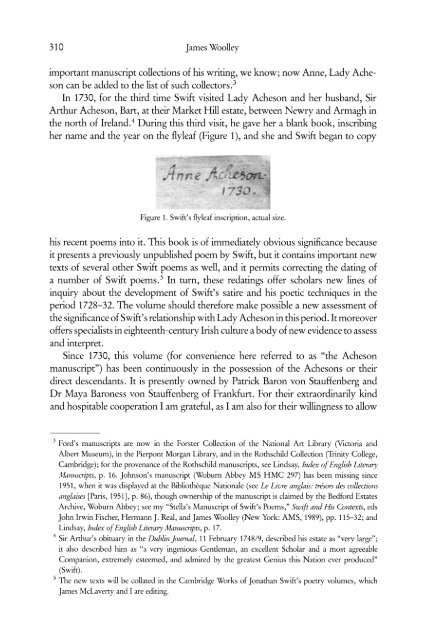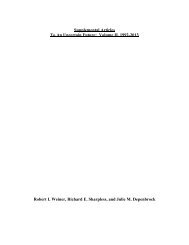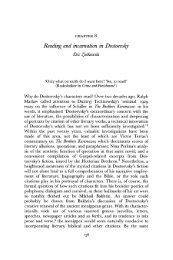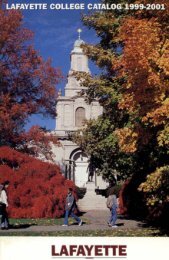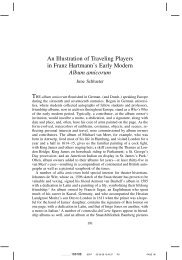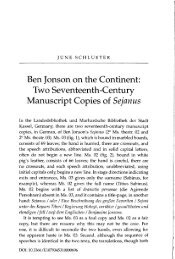Swift's “Skinnibonia”: A New Poem from Lady ... - Lafayette College
Swift's “Skinnibonia”: A New Poem from Lady ... - Lafayette College
Swift's “Skinnibonia”: A New Poem from Lady ... - Lafayette College
Create successful ePaper yourself
Turn your PDF publications into a flip-book with our unique Google optimized e-Paper software.
310<br />
James Woolley<br />
important manuscript collections of his writing, we know; now Anne, <strong>Lady</strong> Acheson<br />
can be added to the list of such collectors.3<br />
In 1730, for the third time Swift visited <strong>Lady</strong> Acheson and her husband, Sir<br />
Arthur Acheson, Bart, at their Market Hill estate, between <strong>New</strong>ry and Armagh in<br />
the north of Ireland.4 During this third visit, he gave her a blank book, inscribing<br />
her name and the year on the flyleaf (Figure 1), and she and Swift began to copy<br />
Figure 1. Swift’s flyleaf inscription, actual size.<br />
his recent poems into it. This book is of immediately obvious significance because<br />
it presents a previously unpublished poem by Swift, but it contains important new<br />
texts of several other Swift poems as well, and it permits correcting the dating of<br />
a number of Swift poems.5 In turn, these redatings offer scholars new lines of<br />
inquiry about the development of Swift’s satire and his poetic techniques in the<br />
period 1728-32. The volume should therefore make possible a new assessment of<br />
the significance of Swift’s relationship with <strong>Lady</strong> Acheson in this period. It moreover<br />
offers specialists in eighteenth-century Irish culture a body of new evidence to assess<br />
and interpret.<br />
Since 1730, this volume (for convenience here referred to as “the Acheson<br />
manuscript”) has been continuously in the possession of the Achesons or their<br />
direct descendants. It is presently owned by Patrick Baron von Stauffenberg and<br />
Dr Maya Baroness von Stauffenberg of Frankfurt. For their extraordinarily kind<br />
and hospitable cooperation I am grateful, as I am also for their willingness to allow<br />
3 Ford’s manuscripts are now in the Forster Collection of the National Art Library (Victoria and<br />
Albert Museum), in the Pierpont Morgan Library, and in the Rothschild Collection (Trinity <strong>College</strong>,<br />
Cambridge); for the provenance of the Rothschild manuscripts, see Lindsay, Index of English Literary<br />
Manuscripts, p. 16. Johnson’s manuscript (Woburn Abbey MS HMC 297) has been missing since<br />
1951, when it was displayed at the Bibliothèque Nationale (see Le Livre anglais: trésors des collections<br />
anglaises [Paris, 1951], p. 86), though ownership of the manuscript is claimed by the Bedford Estates<br />
Archive, Woburn Abbey; see my “Stella’s Manuscript of Swift’s <strong>Poem</strong>s,” Swift and His Contexts, eds<br />
John Irwin Fischer, Hermann J. Real, and James Woolley (<strong>New</strong> York: AMS, 1989), pp. 115-32; and<br />
Lindsay, Index of English Literary Manuscripts, p. 17.<br />
Sir Arthur’s obituary in the Dublin Journal, 11 February 1748/9, described his estate as “very large”;<br />
it also described him as “a very ingenious Gentleman, an excellent Scholar and a most agreeable<br />
Companion, extremely esteemed, and admired by the greatest Genius this Nation ever produced”<br />
(Swift).<br />
5 The new texts will be collated in the Cambridge Works of Jonathan Swift’s poetry volumes, which<br />
James McLaverty and I are editing.


